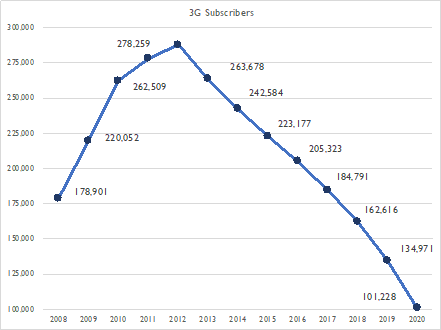The most significant change to the mobile industry since the creation of mobile data is approaching completion. Mobile carriers have been actively transitioning their 3G spectrum to 4G and 5G networks. As the end approaches, more aggressive steps are being taken to complete that transition.
Verizon Wireless announced the complete shutdown of their 3G network and discontinuation of support for all 3G devices by the end of 2019. AT&T Wireless has not made a public announcement regarding an exact date for 3G network shutdown, but the writing is on the proverbial wall. The carrier has not allowed any new 3G only devices into their certification lab since June of 2017. AT&T Wireless also recently announced its plan to launch a nationwide 5G network in 2020. A buildout that cannot be achieved without serious cannibalization of the current 3G network if not an outright complete transition. The end of 3G is almost complete in the US and the most serious risk that poses is not the impact on consumers, but the impact on the telematics/machine to machine (M2M) market.
Network Sunsetting and Telematics Market Implications
There are over 100 million 3G devices currently deployed in the United States.Consumers will upgrade to a relatively low cost 4G LTE device and though they might find that to be annoying, it will not significantly impact the market. Upgrading machine to machine (M2M) telematics devices is a different process all together. These devices are owned by businesses of all sizes across healthcare, transportation, manufacturing, utilities, and many other industries. These industries and their customers rely on a vast number of connected devices that have been installed in conjunction with long term use applications. This makes them more difficult and expensive to upgrade to 4G or 5G.
Examples of these devices include GPS, asset tracking, medical monitoring and security solutions. The process for upgrading these devices to 4G LTE requires coordination, human intervention and in some cases the temporary loss of high cost, revenue generating assets.
Driving Factors behind the Q4 2019 deadline
So why the hurry to migrate these 3G networks by the end of the year? How can an enterprise managing telematics devices know for certain that the Q4 2019 deadline is real and the transition should already be underway?
A. The US Mobile Handset Market
4G LTE covers more than 97% of the US population. The impact of carriers making the decision to transition to 4G began several years ago when they only began purchasing 4G LTE handsets and chipset makers began only making 4G LTE capable chipsets. Over time consumers across the country upgraded their handsets to 4G leaving very few 3G only customers. This leaves little financial motivation for carriers to maintain their 3G networks. They have now lost economies of scale and are far more expensive to operate than 4G LTE technologies. Carriers also need low bandwidth real estate to successfully roll out the new 5G networks coming to market.

B. 5G Buildout
5G buildout is the primary factor driving the 3G network shutdown by the end of the year. Mobile operators have been pushing customers to upgrade to 4G LTE because they will be aggressively transitioning low band 3G spectrum for redeployment in 5G network builds. Verizon Wireless announced the shutdown of its entire 3G network no later than Q4 2019 in order to redeploy their low band spectrum for 5G. AT&T, the dominant holder of low band spectrum in the US, relies on this spectrum for 3G and will need to re-farm significant portions of it to accomplish its goal of a Q1 2020 nationwide 5G network.
C. Spectrum Re-Farming
Low band spectrum is required to successfully deploy a 5G network. It is the only spectrum that provides in-building coverage and broad geographic connectivity. It is also not available for mobile operators to simply go out and purchase. The FCC recently made new millimeter wave spectrum available through its auction process for 5G. That spectrum has significant capacity but limited geographic reach. Carriers invested billions of dollars to purchase the new spectrum, but it will need to be augmented with the lower band spectrum providing the in-building coverage and geographic range for a viable nationwide 5G network. Because there is no new low band spectrum for carriers to purchase, they have to pull from their existing pool which is the network currently used for 3G. Low band spectrum is considered extremely valuable real estate for mobile carriers.
Network Sunsetting Process and Signal Degradation
Carriers begin the sunsetting of a network well before the final shutdown deadline. In the early stages of network sunsetting, mobile operators slowly remove extra network capacity and in some cases coverage from the old network as it is needed to augment existing and newer technology networks. Degradation of service becomes increasingly apparent in the latter stages of spectrum re-farming as core coverage and capacity are more aggressively transitioned from the old network to the new network. Quality of service (QOS) can degrade over time to the minimal QOS contractual commitment. Devices and services dependent on guaranteed connectivity run the risk of no longer functioning as intended.
This sunsetting process and corresponding timeline should have been communicated to all affected businesses utilizing 3G networks for their telematics devices. A plan for transitioning out of 2G and 3G devices in time to mitigate services disruption should already be under way if not close to completion. However, some companies dependent on telematics devices are not aware of the process a network goes through prior to a complete shutdown and do not understand the risk.
Once recognized, there will be a limited amount of time to efficiently transition those devices to 4G. Companies will need to make a change quickly which can significantly increase the expense of doing so. Beginning the migration process and developing risk mitigation strategies is time sensitive and requires immediate action. Depending on the industry and company making the change, there are multiple options for an efficient transition.
Next Steps
Many companies and business solutions that depend on mobile connectivity rely on a procurement department to manage carrier contracts. Others have more hands-on involvement but may be purchasing services through a third party rather than directly from the carrier. It is critical that business owners play a more active role in understanding the implications of these changes as well as the opportunities created as new services can be enabled with next generation mobile technology. Beginning the transition planning process and developing risk mitigation strategies is time sensitive and there are multiple options for making a smooth transition.

